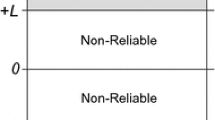Abstract
Based on BCJR algorithm proposed by Bahlet al and linear soft decision feedback, a reduced-complexity parallel interference cancellation (simplified PIC) for convolutionally coded DS CDMA systems is proposed. By computer simulation, we compare the simplified PIC with the exact PIC. It shows that the simplified PIC can achieve the performance close to the exact PIC if the mean values of coded symbols are linearly computed in terms of the sum of initiala prior log-likelihood rate (LLR) and updateda prior LLR, while a significant performance loss will occur if the mean values of coded symbols are linearly computed in terms of the updateda prior LLR only. Meanwhile, we also compare the simplified PIC with MF receiver and conventional PICs. The simulation results show that the simplified PIC dominantly outperforms the MF receiver and conventional PICs, at signal-noise rate (SNR) of 7 dB, for example, the bit error rate is about 10−4 for the simplified PIC, which is far below that of matched-filter receiver and conventional PIC.
Similar content being viewed by others
References
Lupas R, Verdu S. Linear Multiuser Detectors for Synchronous Code-Division Multiple-Access Channels.IEEE Trans Inform Theory, 1989,35(1): 123–136.
**e Z, Short R T, Rushforth G K. A Family of Suboptimum Detectors for Coherent Multiuser Communications.IEEE J Select Areas Commun, 1990,8(4): 683–690.
Varanasi M K, Aazhang B. Multistage Detection in Asynchronous Code-Division Multiple-Access Communications.IEEE Trans Commun, 1990,38(4):509–519.
Nahler A, Irmer R, Fettweis G. Reduced and Differential Parallel Interference Cancellation for CDMA Systems.IEEE J Select Areas Commun, 2002,20(2):237–247.
Sanada Y, Wang Q. A Co-Channel Interference Cancellation Technique Using Orthogonal Convolutional Codes.IEEE Trans on Commun, 1996,44(5):549–556.
Okawa K, Higuchi K, Sawahashi M. Parallel-Type Coherent Multi-Stage Interference Canceller with Iterative Channel Estimation Using both Pilot and Decision-Feedback Data Symbols for W-CDMA Mobile Radio.Proceedings of PIMRC, IEEE, 2000,1:709–714.
Bahl L R, Cocke J, Jelinek F,et al. Optimal Decoding of Linear Codes for Minimizing Symbol Error Rate.IEEE Trans on Commun, 1976,IT-20(5):284–287.
Divsalar D, Simon M K, Raphaeli D. Improved Parallel Interference Cancellation for CDMA.IEEE Trans Commun, 1998,46(2):258–268.
Stienstra D, Khandani A K. Iterative Multi-User Turbo-Code Receiver for DS-CDMA.Proceedings of ICC, IEEE, 2001,3:842–846.
Wang X, Vincent H. Iterative (Turbo) Soft Interference Cancellation and Decoding for Coded CDMA.IEEE Trans on Commun, 1999,47(7):1046–1061.
Author information
Authors and Affiliations
Corresponding author
Additional information
Foundation item: Supported by the National Natural Science Foundation of China (69772015)
Biography: Xu Guo-xiong (1967-), male, Ph. D candidate, research direction: wireless communication.
Rights and permissions
About this article
Cite this article
Guo-xiong, X., Liang-cai, G. & Tian-xi, H. New parallel interference cancellation for convolutionally coded CDMA systems. Wuhan Univ. J. Nat. Sci. 9, 78–82 (2004). https://doi.org/10.1007/BF02912723
Received:
Issue Date:
DOI: https://doi.org/10.1007/BF02912723




